Pendergast T., Pendergast S. St. James Encyclopedia of Popular Culture. Volume 1: A-D
Подождите немного. Документ загружается.

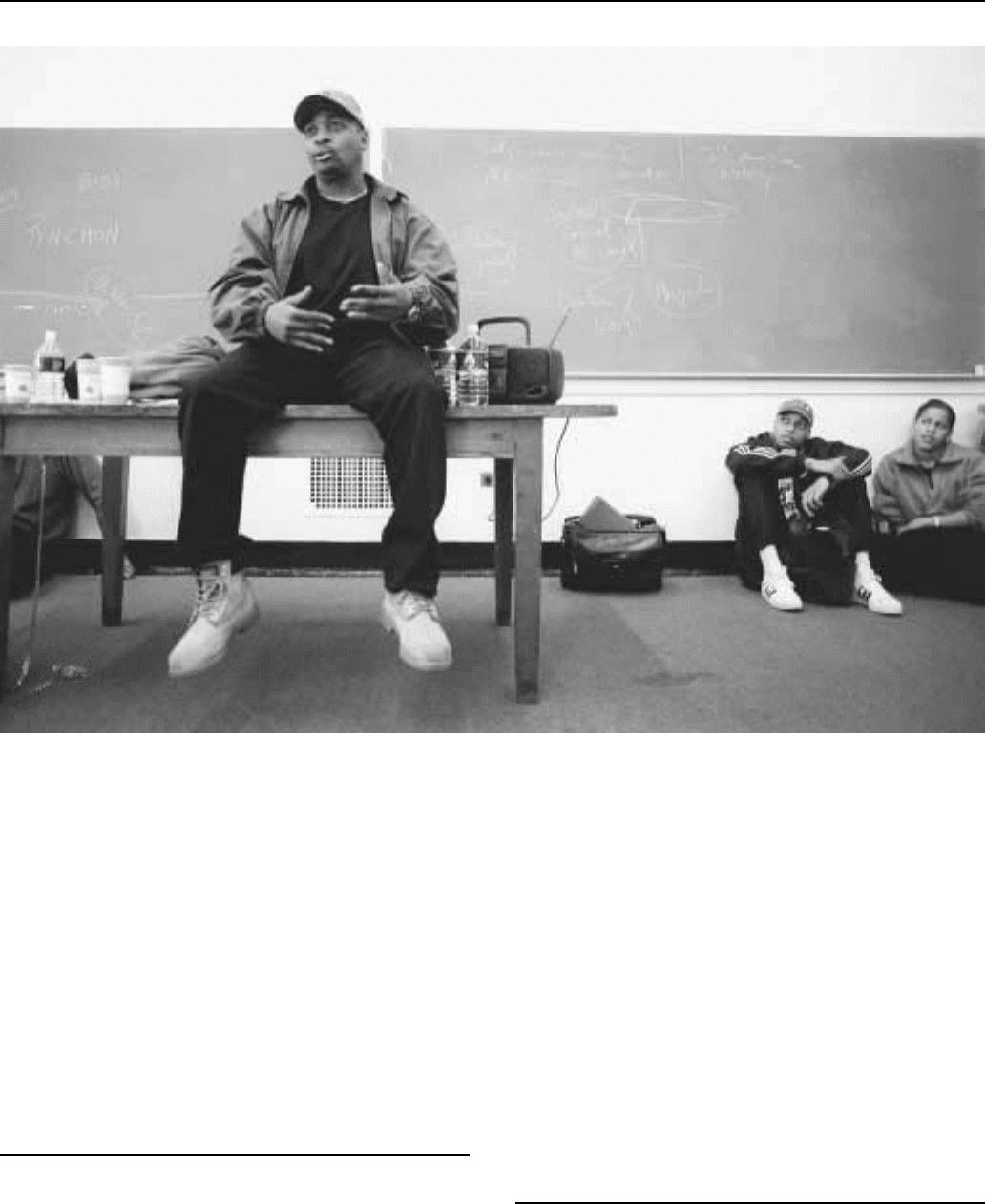
CHURCH SOCIALSENCYCLOPEDIA OF POPULAR CULTURE
509
Chuck D speaks to Columbia University students in 1998.
never changed Public Enemy’s course, and in 1998 the group released
a highly political and sonically dense soundtrack album for Spike
Lee’s film He Got Game.
—Kembrew McLeod
F
URTHER READING:
Chuck D. Fight the power: Rap, Race, and Reality. New York,
Delacorte Press, 1997.
Fernando, S.H., Jr. The New Beats: Exploring the Music, Culture, and
Attitudes of Hip-Hop. New York, Anchor Books, 1994.
Chun King
Chun King was one of the earliest brands of mass-marketed
Chinese food in the United States, offering convenient ‘‘exotic’’
dinners in a can. Beginning with chicken chow mein in 1947, Chun
King later expanded its menu to include eggrolls and chop suey.
Although chow mein was Chinese-American, the maker of Chun
King foods was not. The founder and president of Chun King was
Jeno F. Paulucci, the son of Italian immigrants. Paulucci began his
career in the food industry working in a grocery, and later sold fruits
and vegetables from a car. Paulucci saw an opportunity in Chinese
food and began canning and selling chow mein. The business grew
into a multi-million dollar industry, and in the late 1960s Paulucci
sold the company for $63 million. In the 1990s ConAgra and Hunt-
Wesson marketed Chun King chow mein, beansprouts, eggrolls,
and sauces.
—Midori Takagi
F
URTHER READING:
Cao, Lan, and Himilce Novas. Everything You Need to Know About
Asian-American History. New York, Penguin, 1996.
Church Socials
A gathering of church members for celebratory, social, or
charitable purposes, church socials in America have remained popu-
lar—while becoming more varied and elaborate—throughout the past
two centuries.

CIGARETTES ENCYCLOPEDIA OF POPULAR CULTURE
510
Church socials in America are rooted in ancient Jewish festivals.
Jews traveled to Jerusalem to participate in public worship activities
that commemorated important events or celebrated the harvest.
Because the tribes of Israel were separated geographically, these
festivals served the additional purpose of providing the cement
needed for national unity. Old prejudices and misunderstandings
were often swept away by these major events.
With the birth of the church, Christians shared common meals
designed to enhance relationships within the church. The Bible says
in Acts 2:46, ‘‘. . . They broke bread in their homes and ate together
with glad and sincere hearts.’’ Eventually, the Agape meal or ‘‘love
feast’’ became popular. It provided fellowship and opportunity to
help the poor and widows. It was later practiced in the Moravian and
Methodist churches.
Socials enhance church celebrations of Easter, Christmas, and
other holidays. Because the Bible says that Jesus’ resurrection took
place at dawn, Christians often meet together early on Easter morning
for a ‘‘Sunrise Service’’ followed by a breakfast. An Easter egg hunt
is often included, though some frown on this as a secular activity.
Churches plan various Christmas socials such as caroling, exchang-
ing gifts, and serving special dinners. Opinions vary on whether to
include Christmas trees and Santa Claus. Some avoid them as secular
symbols while others include them because they believe these tradi-
tions have Christian origins. As American society embraced other
holidays such as Mother’s Day, Father’s Day, Valentine’s Day, the
Fourth of July, and Thanksgiving, churches discovered fresh opportu-
nities for social activities including mother-daughter, father-son,
sweetheart, and Thanksgiving banquets. Churches in communities
sometimes join together for patriotic celebrations on the Fourth of July.
Socials get people together in informal settings so that they will
become better acquainted and work together more effectively in the
church. Congregations in rural and small town America enjoy popular
social activities involving food and games. Ham, bean, and cornbread
dinners, chili suppers, ‘‘pot luck’’ meals, homemade ice cream
socials, wiener roasts, picnics, hayrides, softball games, watermelon
eating contests, and all-day singing events are only a few examples. In
fact, for these rural congregations, church socials have often been the
only source of social activities in a community. In some cases, homes
were so far apart, separated by acres of farmland, that churches were
the only places where people could go to meet others. Many people
went to church socials on dates, and was a place where they often met
their future spouses. Some churches included dancing and alcoholic
beverages, but others believed those activities were inappropriate for
churches to sponsor. Churches in both rural and urban areas often
have family nights designed especially for busy families. A family
comes to church on a weeknight and shares a meal with other families
before Bible study or other small group activities.
In the latter half of the twentieth century, churches began
planning more elaborate socials. Churches in or near urban areas
attend professional sports. This is so widespread that most profession-
al stadiums offer discount rates for church groups. Churches join
together to sponsor basketball, softball, and volleyball leagues. While
most churches rent community facilities, some have built their own
gymnasiums and recreation halls. Other social activities involve trips
to major recreation areas such as amusement parks. Swimming,
picnicking, camping, and enjoying amusement rides are a few of the
activities that round out these outings that last whole days or even
entire weekends. Some church groups in recent years have provided
cruises, trips to major recreational sites such as Branson, Missouri,
and even vacations to other countries. While more elaborate, a cruise
for Christian singles, for example, serves the same purpose as the
traditional hayride and wiener roast.
As the early church was concerned for widows, orphans, the sick
and the poor, and gave generously to meet those needs, so modern
church socials may be founded on the desire to assist the needy or
fund church programs. As a result, activities such as homemade-ice-
cream socials, sausage-and-pancake suppers, and craft bazaars are
opened to the public. Some Catholic churches sponsor festivals that
take on the flavor of county fairs. Amusement rides, carnival games,
and food booths draw thousands of people. Money is used to pay for
parochial schools or some other church project. (Some Catholic and
many non-Catholic churches believe that these activities are too
secular. Card playing, gambling, and the drinking of alcoholic bever-
ages included in some of these events have also been quite controver-
sial.) Some churches use their profits to support Christian retirement
homes and hospitals. Some believe churches should not sell food or
merchandise, but they give free meals away to the poor in the
community. Other groups such as the Amish still have barn raising
and quilting socials to help others in their community.
—James H. Lloyd
F
URTHER READING:
Clemens, Frances, Robert Tully, and Edward Crill. Recreation in the
Local Church. Elgin, Ill., Brethren Press, 1961.
Conner, Ray. A Guide to Church Recreation. Nashville, Convention
Press, 1977.
Roadcup, David, ed. Methods for Youth Ministry: Leadership Devel-
opment, Camp, VBS, Bible Study, Small Groups, Discipline, Fine
Arts, Film, Mission Trips, Recreation, Retreats. Cincinnati, Stand-
ard Publishing, 1986.
Smith, Frank Hart. Social Recreation and the Church. Nashville,
Convention Press, 1983.
Cigarettes
It is highly unlikely that in 1881, when James A. Bonsack
invented a cigarette-making machine, that he or anybody else could
have predicted the mélange of future symbolism contained in each
conveniently packaged stick of tobacco. The cigarette has come to
stand for more than just the unhealthy habit of millions in American
popular culture. It represents politics, money, image, sex, and freedom.
The tobacco plant held residence in the New World long before
Columbus even set sail. American Indians offered Columbus dried
tobacco leaves as a gift and, it is rumored, he threw them away
because of the fowl smell. Later on, however, sailors brought tobacco
back to Europe where it gained a reputation as a medical cure-all.
Tobacco was believed to be so valuable that during the 1600s, it was
frequently used as money. In 1619, Jamestown colonists paid for their
future wives’ passage from England with 120 pounds of tobacco. In
1621, the price went up to 150 pounds per mate. Tobacco later helped
finance the American Revolution, also known as ‘‘The Tobacco
War,’’ by serving as collateral for loans from France.
Tobacco consumption took many forms before reaching the
cigarette of the modern day. Spanish colonists in the New World
smoked tobacco as a cigarito: shredded cigar remnants rolled in plant
husks, then later in crude paper. In France, the cigarito form was also
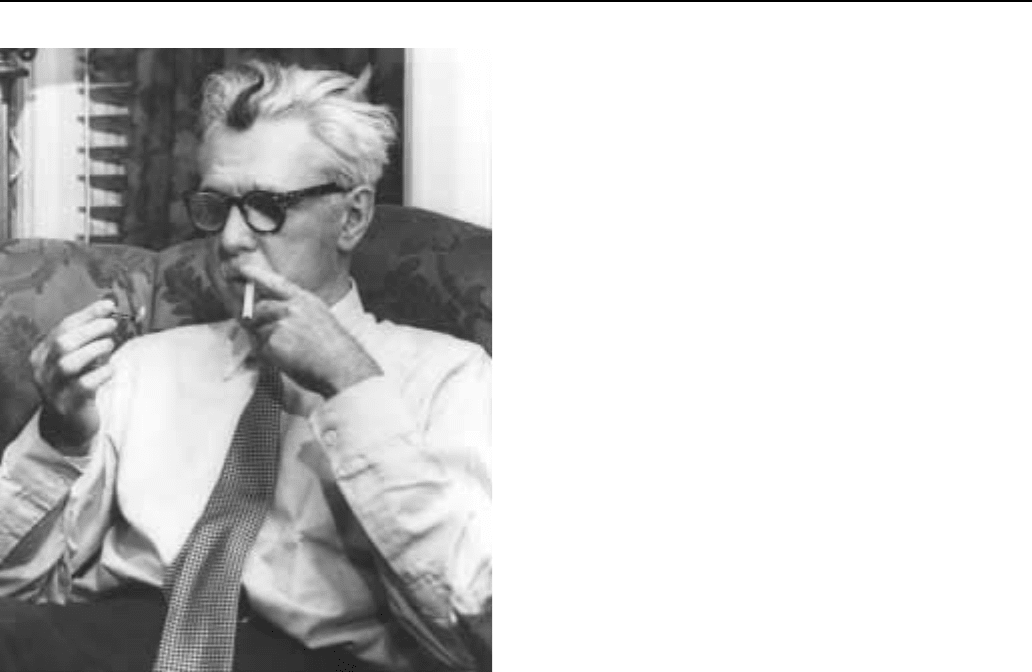
CIGARETTESENCYCLOPEDIA OF POPULAR CULTURE
511
James Thurber enjoying a cigarette.
popular, especially during the French Revolution. As aristocrats
commonly consumed the snuff version of tobacco, the masses chose
an opposing form. A moderate improvement to the Spanish cigarito,
the French cigarette was rolled in rice straw. In 1832, an Egyptian
artilleryman in the Turkish/Egyptian War created the paperbound
version of today whose popularity spread to the British through
veterans of the Crimean War. In England, a tobacconist named Philip
Morris greatly improved the quality of the Turkish cigarette but
still maintained only a cottage industry, despite the cigarette’s
growing popularity.
By the 1900s cigarettes rose to the highest selling form of
tobacco on the market. Mass urbanization picked up the pace of daily
life and popularized factory-made products such as soap, canned
goods, gum, and the cigarette. James A. Bonsack’s newly invented
cigarette machine could turn out approximately 200 cigarettes per
minute, output equal to that of forty or fifty workers. Cigarettes were
now a more convenient form of tobacco consumption—cleaner than
snuff or chew, more portable than cigars or pipes—and also were
increasingly more available. England’s Philip Morris set up shop in
America as did several other tobacco manufacturers: R.J. Reynolds
(1875), J.E. Liggett (1849), Duke (1881, later, the American Tobacco
Company), and the oldest tobacco company in the United States, P.
Lorillard (1760). The cigarette quickly became enmeshed in Ameri-
can popular culture. In 1913, R.J. Reynolds launched its Camel brand
whose instant appeal, notes Richard Kluger in Ashes to Ashes, helped
inspire this famous poem from a Penn State publication: ‘‘Tobacco is
a dirty weed. I like it. / It satisfies no moral need. I like it. / It makes
you thin, it makes you lean / It takes the hair right off your bean / It’s
the worst darn stuff I’ve ever seen. / I like it.’’ Since their introduc-
tion, cigarettes have maintained a status as one of the best-selling
consumer products in the country. In 1990, 4.4 billion cigarettes were
sold in America. That same year, several states restricted their sale.
The greatest propagator of what King James I of England
referred to as ‘‘the stinking weed,’’ has been war: the American
Revolution, the French Revolution, the Mexican and Crimean Wars,
the U.S. Civil War, and the greatest boost to U.S. cigarette consump-
tion—World War I. During the first World War, cigarettes were
included in soldiers’ rations and as Kluger suggests, ‘‘quickly became
the universal emblem of the camaraderie of mortal combat, that
consummate male activity.’’ Providing the troops with their daily
intake of cigarettes, a very convenient method of consumption during
combat, was viewed as morale enhancing if not downright patriotic.
Regardless of intention, the tobacco manufacturers ensured them-
selves of a future market for their product.
At the same time, women became more involved in public life,
earning the right to vote in 1920, and entering the work force during
the absence of the fighting men. Eager to display their new sense of
worth and fortitude, women smoked cigarettes, some even publicly.
The tobacco industry responded with brands and advertisements
aimed especially at women. While war may have brought the ciga-
rette to America, marketing has kept it here. Since the introduction of
the cigarette to America, the tobacco industry has spent untold
billions of dollars on insuring its complete assimilation into U.S.
popular culture. Despite the 1971 ban of radio and television adver-
tisements for cigarettes, the industry has successfully inducted char-
acters such as Old Joe Camel, The Marlboro Man, and the Kool
Penguin into the popular iconography. A 1991 study published by the
Journal of the American Medical Association revealed that 91 percent
of six year olds could identify Joe Camel as the character representing
Camel cigarettes and that Joe Camel is recognized by preschoolers as
often as Mickey Mouse. Aside from advertising, cigarettes have been
marketed, most notably to the youth market, through a myriad of other
promotional activities from industry-sponsored sporting and enter-
tainment events to product placement in movies. In 1993 alone, the
tobacco industry spent $6 billion keeping their cigarettes fresh in the
minds of Americans.
While Hollywood has inadvertently, and sometimes quite inten-
tionally, made the cigarette a symbol of glamour and sexuality—the
smoke gingerly billowing as an afterglow of, or substitute for, the act
itself—anti-tobacco activists have equally pursued an agenda of
disclosure, regulation, and often, prohibition. A war has been waged
on the cigarette in America and everyone, smoker or not, was engaged
by the end of the 1990s. The health hazards of smoking have been
debated since at least the 1600s, but litigation in the twentieth century
revealed what the tobacco industry had known but denied for years:
that nicotine, the active substance in cigarettes, is an addictive drug,
and that cigarette smoking is the cause of numerous diseases and
conditions which claim the lives of nearly half a million Americans
each year. The cigarette has thus become for many an emblem of
deception and death for the sake of profit, or even, with the discovery
of second-hand smoke as a carcinogen, a catalyst for social review.
For others, it remains a symbol of money and power and politics or the
Constitutional First Amendment invoked by so many smokers in their
time of need. The cigarette is indeed a dynamic symbol in American
society—habit, hazard, inalienable right.
—Nadine-Rae Leavell

CIRCUS ENCYCLOPEDIA OF POPULAR CULTURE
512
FURTHER READING:
Glantz, Stanton A., and John Slade, Lisa A. Bero, Peter Hanauer,
Deborah E. Barnes. The Cigarette Papers. Berkeley, University of
California Press, 1996.
Kluger, Richard. Ashes to Ashes: America’s Hundred-Year Cigarette
War, the Public Health, and the Unabashed Triumph of Philip
Morris. New York, Vintage Books, 1996.
McGowen, Richard. Business, Politics, and Cigarettes: Multiple
Levels, Multiple Agendas. San Rafael, California, Quantum
Books, 1995.
Smith, Jane Webb. Smoke Signals: Cigarettes, Advertising, and the
American Way of Life: An Exhibition at the Valentine Museum,
Richmond, Virginia, April 5-October 9, 1990. Chapel Hill, North
Carolina Press, 1990.
Circus
Long before the advent of film, television, or the Internet, the
circus delivered the world to people’s doorsteps across America.
Arriving in the United States shortly after the birth of the American
republic, the growth of the circus chronicled the expansion of the new
nation, from an agrarian backwater to an industrial and overseas
empire. The number of circuses in America peaked at the turn of the
twentieth century, but the circus has cast a long shadow on twentieth
century American popular culture. The circus served as subject matter
for other popular forms like motion pictures and television, and its
celebration of American military might and racial hierarchy percolat-
ed into these new forms. From its zenith around 1900, to its decline
and subsequent rebirth during the late twentieth century, the circus
has been inextricably tied to larger social issues in American culture
concerning race, physical disability, and animal rights.
In 1793, English horseman John Bill Ricketts established the
first circus in the United States. He brought together a host of familiar
European circus elements into a circular arena in Philadelphia:
acrobats, clowns, jugglers, trick riders, rope walkers, and horses. By
the turn of the twentieth century, the circus had become a huge, tented
amusement that traveled across the country by railroad. In an age of
monopoly capitalism, American circuses merged together to form
giant shows; for example, the Ringling Brothers circus bought
Barnum and Bailey’s Greatest Show on Earth in 1907. The biggest
shows employed over 1,000 people and animals from around the
world. These circuses contained a free morning parade, a menagerie
and a sideshow. Their canvas big tops could seat 10,000 spectators
and treated audiences to three rings and two stages of constant
entertainment. Contemporary critics claimed that the circus was ‘‘too
big to see all at once.’’ In the early 1900s, nearly 100 circuses, the
biggest number in American history, rambled across the country.
In 1900, ‘‘circus day’’ was a community celebration. Before
dawn, hundreds of spectators from throughout a county gathered to
watch the circus train rumble into town. The early morning crowd
witnessed scores of disciplined muscular men, horses, and elephants
transform an empty field into a temporary tented city. In mid-
morning, thousands more lined the streets to experience, up close, the
circus parade of marching bands, calliopes, gilded wagons, exotic
animals, and people winding noisily through the center of town. In the
United States, the circus reached its apex during the rise of American
expansion overseas. Circus proprietors successfully marketed their
exotic performances (even those featuring seminude women) as
‘‘respectable’’ and ‘‘educational,’’ because they showcased people
and animals from countries where the United States was consolidat-
ing its political and economic authority. With its displays of exotic
animals, pageants of racial hierarchy (from least to most ‘‘evolved’’),
and dramatizations of American combat overseas, the circus gave its
isolated, small-town audiences an immediate look at faraway cul-
tures. This vision of the world celebrated American military might
and white racial supremacy. The tightly-knit community of circus
employees, however, also provided a safe haven for people ostracized
from society on the basis of race, gender, or physical disability.
In the early twentieth century, the circus overlapped consider-
ably with other popular amusements. Many circus performers worked
in vaudeville or at amusement parks during the winter once the circus
finished its show season. Vaudeville companies also incorporated
circus acts such as juggling, wire-walking, and animal stunts into their
programs. In addition, the Wild West Show was closely tied to the
circus. Many circuses contained Wild West acts, and several Wild
West Shows had circus sideshows. Both also shared the same
investors. Circuses occasionally borrowed their subject matter from
other contemporary amusements. At the dawning of the American
empire, international expositions like the Columbia Exposition in
Chicago (1893) profitably displayed ethnological villages; thus,
circuses were quick to hire ‘‘strange and savage tribes’’ for sprawling
new ethnological congresses of their own. The new film industry also
used circus subjects. Thomas Edison’s Manufacturing Company
produced many circus motion pictures of human acrobatics, trick
elephants, and dancing horses, among others. Circuses such as the
Ringling Brothers Circus featured early film as part of their novel
displays. During the early twentieth century, the circus remained a
popular film subject in movies like Charlie Chaplin’s Circus (1928)
and Tod Browning’s Freaks (1932). Several film stars, such as Burt
Lancaster, began their show business careers with the circus. Cecil B.
DeMille’s The Greatest Show on Earth won an Oscar for Best Picture
in 1952. These popular forms capitalized on the circus’ celebration of
bodily feats and exotic racial differences.
The American circus began to scale back its sprawling features
in the 1920s, owing to the rise of the automobile and the movies. Most
circuses stopped holding a parade because streets became too con-
gested with cars. As motion pictures became increasingly sophisticat-
ed—and thus a more realistic mirror of the world than the circus—
circuses also stopped producing enormous spectacles of contempo-
rary foreign relations. Yet, despite its diminishing physical presence,
the circus was still popular. On September 13, 1924, 16,702 people,
the largest tented audience in American history, gathered at Concordia,
Kansas, for the Ringling Brothers Barnum and Bailey circus. In the
milieu of the rising movie star culture of the 1920s, the circus had its
share of ‘‘stars,’’ from bareback rider May Wirth to aerialist Lillian
Leitzel and her dashing trapeze artist husband, Alfredo Codona. Like
their movie star counterparts in the burgeoning consumer culture,
circus stars began to advertise a wealth of products in the 1920s—
from soap to sheet music. Leitzel became so famous that newspapers
around the world mourned her death in 1931, after she fell when
a piece of faulty equipment snapped during a performance in
Copenhagen, Denmark.
During the Great Depression, the colorful traveling circus pro-
vided a respite from bleak times. When nearly a quarter of the United

CISNEROSENCYCLOPEDIA OF POPULAR CULTURE
513
States workforce was periodically unemployed, clown Emmett Kelly
became a national star as ‘‘Willie,’’ a tramp character dressed in rags,
a disheveled wig, hat, and smudged face, who pined for lost love and
better circumstances. The circus continued to profit during World
War II, when railroad shows traveled under the auspices of the Office
of the Defense Transportation. Circuses exhorted Americans to
support the war effort. Yet Ringling Brothers and Barnum and
Bailey’s ‘‘Greatest Show On Earth’’ nearly disintegrated after 168
audience members died in a big top fire (sparked by a spectator who
dropped a lit cigarette) during a performance in Hartford, Connecti-
cut, on July 6, 1944.
By the early 1950s, circus audience numbers were in decline, in
part because the circus no longer had a monopoly on novelty or
current events. Television, like movies and radio, provided audiences
with compelling and immediate images that displaced the circus as an
important source of information about the world. Yet, as a way to link
itself to familiar, well-established popular forms, early television
often featured live circus and vaudeville acts; circus performers were
also featured on Howdy Doody as well as game shows like What’s My
Line? Ultimately, however, television offered Americans complete
entertainment in the privacy of the home—which dovetailed nicely
with the sheltered, domestic ethos of suburban America during the
early Cold War. In this milieu, public amusements like movies and
the circus attracted fewer customers. In 1956, just 13 circuses existed
in America. As audiences shrank, showmen scaled back even further
on their labor-intensive operations. Moreover, the rise of a unionized
workforce (during the industrial union movement during the 1930s)
meant that circus owners could no longer depend on a vast, cheap
labor pool. Thus, John Ringling North cut his workforce drastically in
1956 when he abandoned the canvas tent for indoor arenas and
stadiums. Circus employees and fans alike mourned the ‘‘death’’ of
the familiar tented circus—a fixture of the circus business since 1825.
American social movements also transformed the circus. Circus
performances of racial difference became increasingly controversial
during the 1950s. Civil rights leaders had long objected to racist
performances in American popular entertainment, but in the context
of the Cold War between the United States and the Soviet Union,
officials in the United States also protested because they feared that
racist performances would legitimize Soviet claims that American
racism was a product of American capitalism. Consequently, officials
no longer aided circus agents’ efforts to hire foreign performers slated
to work as ‘‘missing links,’’ ‘‘savages,’’ or ‘‘vanishing tribes,’’ and
performances of ‘‘exotic’’ racial difference, particularly at the side-
show, slowly disappeared from the 1950s onward. In addition,
disabled rights activists effectively shut down the circus sideshow and
its spectacles of human abnormality by the early 1980s.
Lastly, the spread of the animal rights movement in the 1970s
transformed the circus. Fearful of picketers and ensuing bad publicity,
several circuses in the 1990s arrive silently at each destination and
stop at night to avoid protesters. Cirque du Soleil, an extraordinarily
successful French Canadian circus from Montreal (with a permanent
show in Las Vegas), uses no animals in its performances. Instead,
troupe members wear tight lycra body suits, wigs, and face paint to
imitate animals as they perform incredible aerial acrobatics to the beat
of a slick, synthesized pop musical score and pulsating laser lights.
Yet, arguably, Cirque du Soleil (among others) is actually not a circus
because of its absence of animals: throughout its long history, the
circus has been defined by its interplay of humans and animals in a
circular arena.
Despite the transformation of its content, the American circus
endures at the turn of the twenty first century. Certainly, towns no
longer shut down on ‘‘circus day,’’ yet a growing number of small
one-ring circuses have proliferated across America. Shows like the
Big Apple Circus, Circus Flora, and Ringling Brothers Barnum and
Bailey’s show, ‘‘Barnum’s Kaleidoscope,’’ have successfully recre-
ated the intimate, community atmosphere of the nineteenth century
one-ring circus, without the exploitation of physical and racial
difference that characterized the older shows. Ultimately, in the
1990s, a decade of increasingly distant, fragmented, mass-mediated,
‘‘virtual’’ entertainment, the circus thrives because it represents one
of the few intimate, live (and hence unpredictable) community
experiences left in American popular culture.
—Janet Davis
F
URTHER READING:
Albrecht, Ernest. The New American Circus. Gainesville, University
Press of Florida, 1995.
Bogdan, Robert. Freak Show: Presenting Human Oddities for Amuse-
ment and Profit. Chicago, University of Chicago Press, 1988.
Cooper, Diana Starr. Night After Night. Washington, D.C., Island
Press, 1994.
Hammarstrom, David Lewis. Big Top Boss: John Ringling North and
the Circus. Urbana and Chicago, University of Illinois Press, 1992.
Speaight, George. A History of the Circus. London, Tantivy Press, 1980.
Taylor, Robert Lewis. Center Ring: The People of the Circus. Garden
City, New York, Doubleday and Co., 1956.
Cisneros, Sandra (1954—)
Born and raised in Chicago, Chicana writer and poet Sandra
Cisneros is best known for The House on Mango Street (1983), a
series of interconnected prose poems. She is one of a handful of
Latina writers to make it big in the American literary scene and the
first Chicana to sign with a large publishing firm. Cisneros graduated
from Loyola University in Chicago and went on to the prestigious
Iowa Writers Workshop at the University of Iowa where she earned
an MFA. Her poetry collections include My Wicked, Wicked Ways
(1987) and Loose Woman (1994). She also has authored a collection
of essays and short stories, Woman Hollering Creek (1991). Her
poems and stories offer a conversational style, chatty and rambling.
Her writing is lean and crisp, peppered with Spanish words.
—Beatriz Badikian
F
URTHER READING:
Doyle, Jacqueline. ‘‘More Room of Her Own: Sandra Cisneros’s The
House on Mango Street.’’ The Journal of the Society for the Study
of the Multi-Ethnic Literature of the United States. Vol. 19, No. 4,
Winter 1995, 5-35.
Kanoza, Theresa. ‘‘Esperanza’s Mango Street: Home for Keeps.’’
Notes on Contemporary Literature. Vol. 25, No. 3, May 1995, 9.
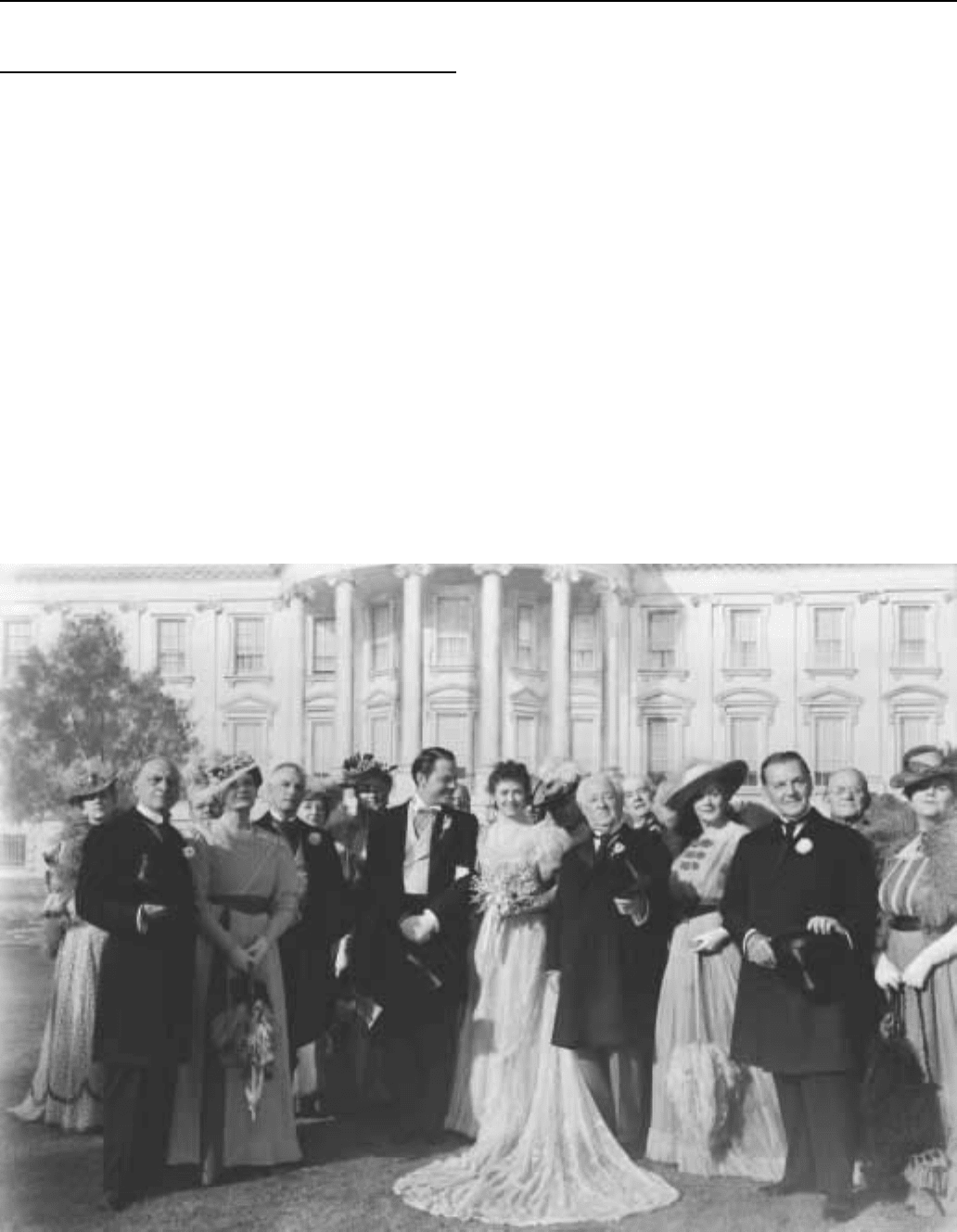
CITIZEN KANE ENCYCLOPEDIA OF POPULAR CULTURE
514
Citizen Kane
Orson Welles’ film Citizen Kane has been consistently ranked as
one of the best films ever made. A masterpiece of technique and
storytelling, the film helped to change Hollywood film-making and
still exerts considerable influence today. However, at the time of its
premiere in 1941, it was a commercial failure that spelled disaster for
Welles’ Hollywood career.
Citizen Kane tells the story of millionaire press magnate Charles
Foster Kane (played by Welles). The film opens with Kane on his
death bed in his magnificent Florida castle, Xanadu, murmuring the
word ‘‘Rosebud.’’ A newsreel reporter (William Alland) searches for
clues to the meaning of the word and to the meaning of Kane himself.
Interviewing many people intimately connected with Kane, the
reporter learns that the millionaire was not so much a public-minded
statesman as he was a tyrannical, lonely man. The reporter never
learns the secret of Kane’s last word. In the film’s final moments, we
see many of Kane’s possessions being thrown into a blazing furnace.
Among them is his beloved childhood sled, the name ‘‘Rosebud’’
emblazoned across it.
Citizen Kane encountered difficulties early on. Welles fought
constantly with RKO over his budget and against limits on his control
of the production. Furthermore, because the film was based in part on
Orson Welles (center) in a scene from the film Citizen Kane.
the life of publisher William Randolph Hearst, Hearst’s papers
actively campaigned against it, demanding that Citizen Kane be
banned and then later refusing to mention or advertise it altogether.
Although the scheme backfired, generating enormous publicity for
the movie, a frightened RKO released the film only after Welles
threatened the studio with a lawsuit.
Critics reacted positively, but were also puzzled. They enthusi-
astically applauded Citizen Kane’s many technical innovations.
Throughout the film, Welles and his crew employed depth of field (a
method in which action in both the foreground and background
clearly are in focus, and used to great effect by cinematographer
Gregg Toland), inventive editing, sets with ceilings, chiaroscuro
lighting, and multilayered sound. Although sometimes used in for-
eign film, many of these techniques were new to Hollywood. They
have since, however, become standard for the industry.
Critics also were impressed by Citizen Kane’s many virtuoso
sequences: a ‘‘March of Time’’-type newsreel recounting the bare
facts of Kane’s life; the breakfast table scene, where in a few minutes
his first marriage deteriorates to the strains of a waltz and variations
(by noted screen composer Bernard Herrmann, in his first film
assignment); a tracking shot through the roof of a nightclub; and a
faux Franco-Oriental opera. None of these sequences, however, are
showstoppers; each propels the narrative forward.
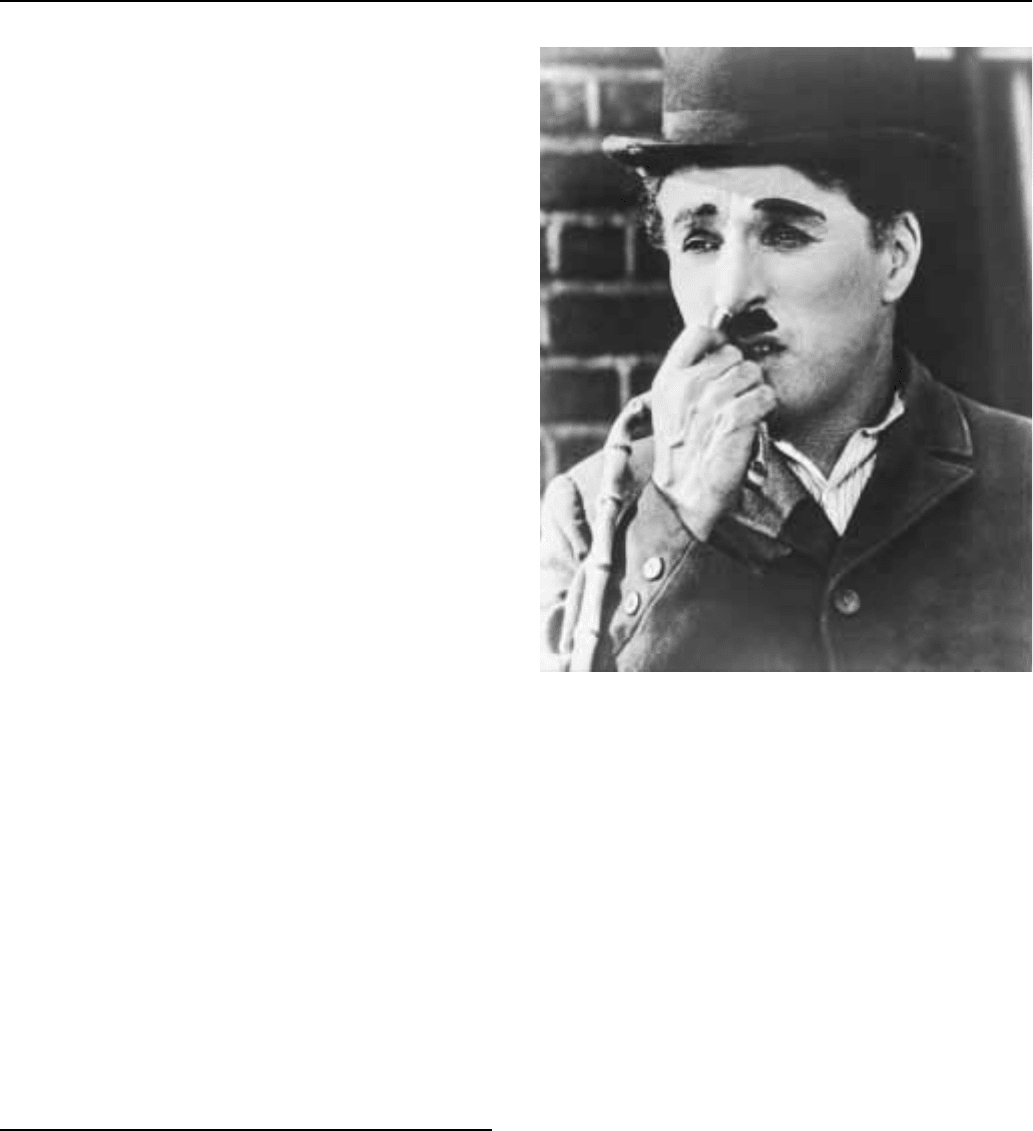
CITY LIGHTSENCYCLOPEDIA OF POPULAR CULTURE
515
That narrative proved puzzling both to critics and to audiences at
large. Written by Herman J. Mankiewicz and Welles (although there
is considerable controversy over how much Welles contributed), the
narrative employs a series of flashbacks that tell different pieces of
Kane’s life story and reveal the witnesses’ various perceptions of him.
By arranging these pieces out of order, the script opened the door for
later screenwriters to avoid the demands of strict chronology. At the
time, however, this innovation confused most audiences.
While Citizen Kane did well in New York, the film did poor
business in small-town America. The film was a commercial failure,
allowing RKO’s officials to eventually let go of Welles. Thereafter,
he found it increasingly difficult to make movies in Hollywood.
Shunned by the studio system, he was forced to spend much of his
time simply trying to raise money for his various projects.
For a while, Citizen Kane itself seemed to suffer a similar fate.
Although the film was nominated for a host of Oscars, Academy
members took RKO’s side in the studio’s battle with Welles, award-
ing the movie only one Oscar for best original screenplay. The film
lost to How Green Was My Valley for best picture. Citizen Kane soon
sank into obscurity, rarely discussed, except when described as the
beginning of the end of Welles’ film career.
After World War II, RKO, seeking to recoup its losses, released
Citizen Kane in European theaters hungry for American films and
also made it available for American television. Exposed to a new
generation of moviegoers, the film received new critical and popular
acclaim. Riding the wave of Citizen Kane’s new-found popularity,
Welles was able to return to Hollywood, directing Touch of Evil in 1958.
Consistently ranked number one on Sight and Sound’s top ten
films list since the mid-1950s, Citizen Kane continues to attract,
inspire, and entertain new audiences. In 1998, it was voted the best
American film of the twentieth century by the American Film Institute.
—Scott W. Hoffman
F
URTHER READING:
Carringer, Robert L. The Making of Citizen Kane. Berkeley, Universi-
ty of California Press, 1996.
Higham, Charles. The Films of Orson Welles. Berkeley, University of
California Press, 1970.
Kael, Pauline. The Citizen Kane Book. Boston, Little, Brown and
Company, 1971.
McBride, Joseph. Orson Welles. New York, Viking Press, 1972.
Naremore, James. The Magic World of Orson Welles. New York,
Oxford University Press, 1978.
City Lights
A silent film at the dawn of the talking picture technological
revolution, City Lights appeared to popular acclaim and remains, for
many, Charlie Chaplin’s finest achievement. When Chaplin, known
the world over for his ‘‘Little Tramp’’ character, began filming City
Lights in 1928, talking pictures had become the rage in the movie
industry, and most filmmakers who had originally conceived of their
works as silent films were now adapting them into partial talkies or
junking them altogether. Chaplin halted production on City Lights to
weigh his options, and, when he resumed work several months later,
he stunned his Hollywood peers by deciding to keep the film in a
Charlie Chaplin in a scene from the film City Lights.
silent form. ‘‘My screen character remains speechless from choice,’’
he declared in a New York Times essay. ‘‘City Lights is synchronized
[to a musical score] and certain sound effects are part of the comedy,
but it is a non-dialogue picture because I preferred that it be that.’’ For
many, the film that resulted is a finely wrought balance of pathos and
comedy, the very quintessence of Chaplin. The movie debuted in 1931.
Chaplin, who not only produced, directed, and starred in City
Lights but also wrote and edited it and composed its musical score,
centered his film on the Little Tramp and his relationship with a
young, blind flower vendor who has mistaken him for a rich man. The
smitten Tramp, not about to shatter her fantasy, undergoes a series of
comic misadventures while trying to raise money for an operation that
would restore her vision. He interrupts the suicide attempt of a
drunken man who turns out to be a millionaire. The two become
friends, but unfortunately the millionaire only recognizes the Tramp
when drunk. Determined to help the young woman, the Tramp takes
on such unlikely occupations as street sweeping and prize fighting
(both of which go comically awry) before the millionaire finally
offers him one thousand dollars for the operation. Robbers attack at
just that moment, knocking the millionaire in the head. Police arrive
and assume the Tramp is the thief (the millionaire, sobered by the
blow, does not recognize him), but the Tramp manages to give the
money to the woman before they catch him and haul him off to jail.
After his release, he discovers that the young woman, now sighted,
runs her own florist shop. She doesn’t recognize the shabbily dressed
Tramp at first and playfully offers him a flower. When she at last
realizes who he is, the film concludes with the most poignant
exchange of glances in the history of world cinema.

CITY OF ANGELS ENCYCLOPEDIA OF POPULAR CULTURE
516
Chaplin found the casting of the nameless young blind woman to
be particularly difficult. According to his autobiography, one of his
biggest challenges ‘‘was to find a girl who could look blind without
detracting from her beauty. So many applicants looked upward,
showing the whites of their eyes, which was too distressing.’’ The
filmmaker eventually settled on Virginia Cherrill, a twenty-year-old
Chicagoan with little acting experience. ‘‘To my surprise she had the
faculty of looking blind,’’ Chaplin wrote. ‘‘I instructed her to look at
me but to look inwardly and not to see me, and she could do it.’’ He
later found the neophyte troublesome to work with, however, and
fired her about a year into production. He recruited Georgia Hale, who
had co-starred with him in The Gold Rush in 1925, to replace her but
eventually re-hired Cherrill after realizing how much of the film he
would have to re-shoot.
Chaplin’s problems extended to other aspects of the movie. He
filmed countless retakes and occasionally stopped shooting for days
on end to mull things over. Most famously, he struggled for eighty-
three days (sixty-two of which involved no filming whatsoever) on
the initial encounter of the Tramp and the young woman, unable to
find a way of having the woman conclude that the Tramp is wealthy.
Inspiration finally struck, and Chaplin filmed a brief scene in which a
limousine door slammed shut a moment before the Tramp met her.
Chaplin’s difficulties on the set mattered little to audiences.
They loved his melancholy yet comic tale of two hard-luck people and
made it an unqualified hit (the movie earned a profit of five million
dollars during its initial release alone). A few reviewers criticized the
film’s old-fashioned, heavily sentimental quality, but the majority
praised Chaplin’s work. Its regressive form and content notwithstand-
ing, City Lights appealed strongly to audiences and critics alike.
—Martin F. Norden
F
URTHER READING:
Chaplin, Charles. My Autobiography. New York, Simon and
Schuster, 1964.
———. ‘‘Pantomime and Comedy.’’ New York Times. January 25,
1931, H6.
Maland, Charles J. Chaplin and American Culture: The Evolution of a
Star Image. Princeton, Princeton University Press, 1989.
Molyneaux, Gerard. Charlie Chaplin’s City Lights. New York,
Garland, 1983.
The City of Angels
The official slogan for the city of Los Angeles (L.A.) is ‘‘Los
Angeles brings it all together.’’ Its unofficial name is ‘‘The City of
Angels.’’ In the first instance, reality belies the motto in that Los
Angeles’ most salient feature is its diffuse layout. In the second, it is
difficult to think of someone saying ‘‘The City of Angels’’ without a
Raymond Chandler-esque sneer. But that, too, is L.A.; duplicitous,
narcissistic, and paradoxical. Perhaps no city has been loved or
abhorred with such equal vigor, or typified by so many contradictions.
For postmodern philosophers (especially Europeans) who study the
city as they would a text, the city fascinates with its sheer moderni-
ty—a tabula rasa over which the thick impasto of America’s aspira-
tions and proclivities has been smeared. Viewed from the air, the city
terrifies with its enormity, but one can discern a map of sorts, a
guidepost pointing towards the future.
From its very beginning Los Angeles has existed more as a sales
pitch than a city; a marketing campaign selling fresh air, citrus fruits,
and the picturesque to the elderly and tubercular. In the 1880s, when
Los Angeles was little more than a dusty border town of Spanish
Colonial vintage, attractively packaged paeans to sun-kissed good-
living were flooding the Midwest. Pasadena was already a well-
known summer destination for East Coast millionaires, and the
campaign sought to capitalize on a keeping-up-with-the-Jones senti-
ment calculated to attract prosperous and status conscious farmers.
Behind the well-heeled came the inevitable array of servants, lackeys,
and opportunists. The farm boom dried-up, and the transplanted,
oftentimes marooned mid-westerners sat on their dusty front porches
wondering where they went wrong—a dominant leit motif of L.A.
literature along with conflagrations, earthquakes, floods, crowd vio-
lence, and abject chicanery.
Until the film industry invaded in the early 1910s, Los Angeles
could offer few incentives to attract industry, lacking a port or even
ready access to coal. The only way civic leaders could entice
businessmen was by offering the most fervently anti-labor municipal
government in the country, and Los Angeles developed a reputation
for quelling its labor unrest with great dispatch. L.A.’s leading lights
were as canny at pitching their real estate holdings as they were
ruthless in ensuring the city’s future prosperity. To insure adequate
water to nourish the growing metropolis, founding father William
Mulholland bamboozled the residents of Owens Valley, some 250
miles to the northeast, into selling their water rights under false
pretenses and building an enormous aqueduct into the San Fernando
Valley. In 1927 the embittered farmers, having witnessed their fertile
land return to desert, purchased an advertisement in the Los Angeles
Times which read: ‘‘We, the farming communities of the Owens
Valley, being about to die, salute you.’’ The publisher of the newspa-
per, General Harrison Gray Otis, was a major investor in Mulholland’s
scheme. Even back then, irony was a way of life in Southern California.
Fate was kind to Los Angeles. With the film industry came
prosperity, and a spur to real estate growth. But beneath the outward
prosperity, signs of the frivolity and moral disintegration L.A. was
famous for provoking were apparent to those with an eye for details.
Thus, Nathaniel West, author of the quintessential Los Angeles novel,
Day of the Locust, could write of a woman in man’s clothing
preaching the ‘‘crusade against salt’’ or the Temple Moderne, where
the acolytes taught ‘‘brain-breathing, secret of the Aztecs,’’ while up
on Bunker Hill, a young John Fante would chronicle the lives of the
hopelessly displaced Midwest pensioners and the sullen ghetto
underclass from his cheap hotel room overlooking downtown. Across
town, European luminaries such as Arnold Schoenberg, Thomas
Mann, and Bertolt Brecht found the leap from Hitler’s Germany to
palm trees and pristine beaches a difficult transition to make. The
contrast between the European exiles and their American counter-
parts was as plain as day, and illustrates the contradictory schools of
thought about the City of Angels. The Europeans regarded the city as
a curiosity to be tolerated, or wondered at, while West, Fante, and
their better known brethren were almost uniform in their strident
denunciations of what they perceived as overt Philistinism. British
novelist Aldous Huxley oscillated between condemnation and ap-
proval. These foreigners perceived the myriad contradictions of Los
Angeles: The beauty of its locale and the crassness of its people; the
film industries’ pollyanna-like flights of fancy and the bitter labor

CIVIL DISOBEDIENCEENCYCLOPEDIA OF POPULAR CULTURE
517
struggles that accompanied their creation; the beauty of the art deco
style that Los Angeles adopted as its own, and the eyesores (building
shaped like hot-dogs, space ships, ginger-bread houses) constructed
alongside them.
For obvious reasons, L.A. became a center for the defense
industry during World War II, and the factories springing up like
mushrooms on the table-flat farmland attracted the rootless detritus of
the Depression, who only a few years back were regularly turned back
at the Nevada border by the California Highway Patrol. The great
influx of transplants flourished in their well-paid aerospace assembly
line jobs, enjoying a semblance of middle class living. It became the
clarion call of a new sales pitch—the suburban myth. The suburbs
marketed a dream, that of single family homes, nuclear families, and
healthful environment. Within a few years, pollution from the legions
of commuters who clogged L.A.’s roadways dispelled the illusion of
country living. Another recent innovation, the shopping mall, while
invented in Seattle, was quickly adopted as a native institution, to the
further degradation of downtown Los Angeles.
The veterans had children, who, nourished on their parent’s
prosperity, became a sizeable marketing demographic. The children
took to such esoteric sports as surfing, hot rodding, and skateboarding,
fostering a nationwide craze for surf music and the stylistic excesses
of hot-rod artists such as Big Daddy Roth. For a time, Los Angeles
persevered under this placid illusion, abruptly collapsed by the 1965
Watts riots and the Vietnam war. In a city without discernible
boundaries, the idea of a city center is an oxymoron. Downtown Los
Angeles, the nexus of old money Los Angeles, slowly withered,
crippled further by urban renewal projects that made the downtown
ghost town something of a self-fulfilling prophecy.
This, then, is L.A., a heady mixture of status and sleaze,
weirdness and conformity, natural beauty and choking pollution. Los
Angeles is indeed the most postmodern of cities, a city with more of a
reflection than an image, and where the only safe stance is the ironic
one. In the early 1990s, L.A. was hit by earthquakes, fires, and another
riot of its black populace, this time provoked by the acquittal of
policeman accused of beating a black motorist more briskly than
usual. Los Angeles once again managed to recover, refusing once
again to be crippled by its inner contradictions. With its limited array
of tropes, the city trots out its endgame against any natural limitations
to its growth. As the city evolves, postmodern theoreticians stand by
rubbing their palms together, predicting the city’s inevitable denoue-
ment while the sun shines mercilessly overhead.
—Michael Baers
F
URTHER READING:
Davis, Mike. City of Quartz. New York, Verso, 1990.
———. Ecology of Fear. New York, Metropolitan Books, 1998.
Didion, Joan. Slouching Towards Bethlehem. New York, Washington
Square Press, 1981.
Fante, John. Ask the Dust. Santa Barbara, Black Sparrow Press, 1980.
Klein, Norman. The History of Forgetting. New York, Verso, 1997.
Lovett, Anthony R., and Matt Maranian. L.A. Bizarro. Los Angeles,
Buzz, 1997.
Pynchon, Thomas. The Crying of Lot 49. New York, Lippincott, 1963.
West, Nathanael. Day of the Locust. New York, Random House, 1939.
Civil Disobedience
Civil disobedience is a nonviolent, deliberate, and conspicuous
violation of a law or social norm, or a violation of the orders of civil
authorities, in order to generate publicity and public awareness of an
issue. Protesters directly confront the rule and confront authorities
who would enforce it, and demand a change in the rule. Civil
disobedience communicates the protesters’ unity and strength of
interest in an issue and provides evidence of their commitment and
willingness to sacrifice for the cause. It also presents a latent threat of
more overt action if the regime fails to act on the issue.
Civil disobedience is a form of political participation available
to citizens without the money, media support, lobbying resources,
voting strength, political skills, or political access necessary to
influence decision-makers through more traditional means. The tactic
was used by Mahatma Gandhi in the 1940s to secure the end of British
colonial rule in India; by Martin Luther King, Jr. and other American
civil rights leaders in the 1960s to end legal racial segregation and to
secure voting rights for African Americans; and by non-voting age
college students during the 1960s to protest America’s war in
Vietnam. Civil disobedience brings people into the political system
who were previously outside the system and is one of the few tactics
available to empower concerned citizens who lack any other means to
press their demands for change. Social minorities and deviant subcul-
tures use civil disobedience to challenge and change the norms of
society or to demand their independence from the rules of society.
Civil disobedience usually takes one of three forms. First, civil
disobedience may take the form of deliberate and purposeful violation
of a specific targeted statute or social norm in order to focus popular
and media attention on the rule, to encourage others to resist the rule,
and to encourage authorities to change the rule. Examples include
1960s American civil rights sit-ins and demands for service at
segregated lunch counters, anti-war protesters refusing to submit to
selective service calls, and feminists publicly removing restrictive
brassieres in protest of clothing norms. In the 1970s, trucker convoys
deliberately exceeded the 55-mile-per-hour federal highway speed
limit to protest the limit. According to Saul Alinsky in Rules for
Radicals, this tactic is effective only in non-authoritarian and non-
totalitarian regimes with a free press to publicize the violation of the
law and basic civil rights to prevent civil authorities and social
majorities from overreacting to the violation.
Second, civil disobedience may take the form of passive resist-
ance in which protesters refuse to respond to the orders of authorities
but are otherwise in full compliance with the law. Examples have
included civil rights protesters and anti-war activists who ignore
police orders to disperse and force police to physically carry them
from a public protest site. Feminists have resisted social norms by
refusing to shave their legs. The organization Civilian Based Defense
promoted passive resistance as a national defense strategy and sug-
gested that the threat of withholding cooperation and engaging in
active non-cooperation with the enemy may be as effective a deterrent
to an invader’s aggression as the use of military force.
Third, civil disobedience may take the form of non-violent
illegal activity in which protesters disrupt activities they oppose and
seek to be arrested, punished, and even martyred to gain publicity and
to influence public opinion. Examples have included anti-war protest-
ers who trespass on military installations and illegally seize military
property by chaining themselves to it, radical environmentalists who
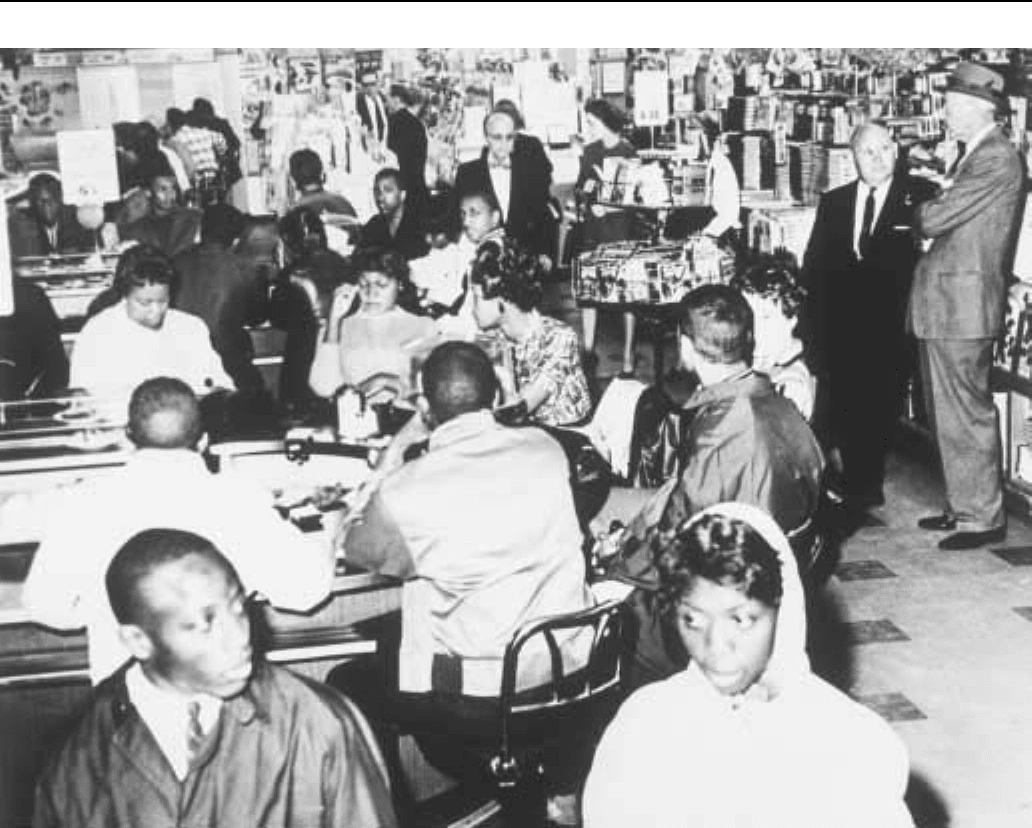
CIVIL DISOBEDIENCE ENCYCLOPEDIA OF POPULAR CULTURE
518
Student protesters at Woolworth’s lunch counter, Atlanta, Georgia, 1960.
‘‘spike’’ trees with nails to disrupt logging activities, and animal
rights activists who throw blood on persons wearing animal fur coats.
Civil disobedience is distinctly different from nonconformity,
social pathology, eccentricity, or social disorganization. Nonconformity
is willful violation of a rule because the values established in the rule
are contrary to the social, cultural, or moral values and norms of a
subgroup of the civil society—but the violation is not intended to
encourage a change in the rule. For example, a fundamentalist
Mormon practices polygamy because he believes religious proscriptions
require him to do so, not because he seeks to change or protest the
marriage laws of the state. Social pathology is the failure to conform
to civil law because failures in the individual’s socialization and
education processes leave the individual normless and, therefore, free
to pursue his personal self-interest and selfish desires without concern
for law. Eccentricity is socially encouraged nonconformance in which a
cultural hero, genius, intellectual, or artist is granted cultural license
to violate the law based on the person’s unique status or contributions
to society. Finally, social disorganization is the failure of the political
or social system to enforce its rules because authority has become
ineffective or has been destroyed in war or revolution, leaving
individuals in a state of anarchy and licensed to make their own rules.
Civil disobedience as a political tactic and social process in-
creases in popularity and use as society decreases its reliance on
violence and force to achieve political goals or to gain the advantage
in social conflict or competition. It also increases in popularity when
political outsiders seek to assert themselves in the political process
and find all other avenues of political participation beyond their
abilities and resources or find all other avenues prohibited to them by
political insiders or by civil authorities.
—Gordon Neal Diem
F
URTHER READING:
Alinsky, Saul. Rules for Radicals. New York, Random House, 1971.
Ball, Terence. Civil Disobedience and Civil Deviance. Beverly Hills,
California, Sage Publications, 1973.
Bay, Christian, and Charles Walker. Civil Disobedience: Theory and
Practice. Saint Paul, Minnesota, Black Rose Books, 1975.
Bedau, Hugo. Civil Disobedience: Theory and Practice. New York,
Pegasus, 1969.
